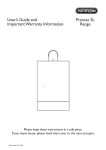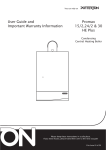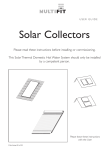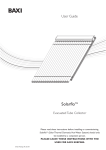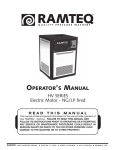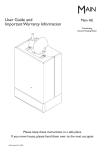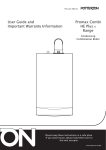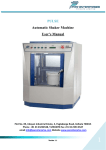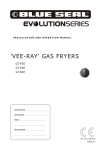Download Baxi Solarflo Evacuated Ttube Facade Quick Start Manual
Transcript
Kit Instructions SolarfloTM Evacuated Tube Collector Facade Mounting These instructions are for the collector mounting only and must be used in conjunction with the Evacuated Tube Collector Installation Guide TM Solarflo (Solar Thermal Domestic Hot Water System) should only be installed by a competent person. PLEASE LEAVE THESE INSTRUCTIONS WITH THE USER FOR SAFE KEEPING. © Baxi Heating UK Ltd 2008 © Baxi Heating UK Ltd 2008. All rights reserved. No part of this publication may be reproduced or transmitted in any form or by any means, or stored in any retrieval system of any nature (including in any database), in each case whether electronic, mechanical, recording or otherwise, without prior written permission of the copyright owner, except for permitted fair dealing under Copyrights, Designs and Patents Act 1988. Applications for the copyright owner’s permission to reproduce or make other use of any part of this publication should be made, giving any details of the proposed use to the following address: The Company Secretary, Baxi Heating UK Ltd,The Wyvern Business Park, Stanier Way, Derby DE21 6BF. Full acknowledgement of author and source must be given. WARNING: Any person who does any unauthorised act in relation to a copyright work may be liable to criminal prosecution and civil claims for damages. 2 © Baxi Heating UK Ltd 2008 CONTENTS Section 1.0 2.0 3.0 4.0 5.0 © Baxi Heating UK Ltd 2008 General Safety Information Risk Assessments Site Requirements General Assembly Notes Structure Lightning protection Connections Collector Inclination Solar Fluid Installation of Solar Collector Collector Orientation Assembly of Kit Facade (Por trait/Landscape) Fitting the Tubes Fitting the Connection Kit Spare Parts Notes Page 4 6 8 13 14 3 1.0 1.1 General Safety information In order to reduce the number of deaths and major accidents attributable to working at height, the Health and Safety Executive has introduced comprehensive regulations and guidance that should be followed by all businesses working at height. We consider in the following paragraphs some of the main features of the regulations and guidance.This is, however, only a limited summary and it is recommended that all businesses planning on undertaking solar water heating installations obtain a copy of the regulations and guidance issued by the Health and Safety Executive and carefully consider the contents. The regulations and guidance state that you are required to carry out a risk assessment for all work conducted at height and to put in place arrangements for: • Eliminating or minimising risks from work at height. • Safe systems of work for organising and performing work at height. • Safe systems for selecting suitable work equipment. • Safe systems for protecting people from the consequences of work at height. The regulations and guidance highlight a hierarchy for safe work at height: • Avoid the risk by not working at height if practicable. • Prevent falls, where it is not reasonably practicable to avoid work at height; you are required to take suitable and sufficient steps to prevent the risk of a fall including selecting the most suitable work equipment (in accordance with the regulations). • Mitigate the consequences of a fall; where the risk of a person or object falling still remains, take suitable and sufficient measures to minimise the distance and consequences of any fall. Collective protection measures, such as guard rails on scaffold, should be given priority over personal protection measures, such as safety harnesses. Within the regulations’ framework, you are required to: a) Assess the risk to help you decide how to work safely. b) Follow the hierarchy for safe work at height (i.e. avoid, prevent and mitigate). c) Plan and organise your work properly, taking account of weather conditions and the possibility of emergencies. d) Make sure those working at height are competent. e) Make use of appropriate work equipment. f) Manage the risks from working on or around fragile surfaces and from falling objects. g) Inspect and maintain the work equipment to be used and inspect the place where the work will be carried out (including access and egress). When preparing to install a solar water heating system, it is required that you perform a risk assessment in relation to work at height and plan how you will organise your work, taking into account the site, the weather conditions and the experience and competence of colleagues or contractors who may be working at height with you. 4 © Baxi Heating UK Ltd 2008 1.0 1.2 General Risk Assessments The HSE has published a number of very useful free publications that advise how to undertake risk assessments. Two of these that you should obtain are: Five Steps to Risk Assessment. A Guide to Risk Assessment Requirements. The five steps outlined in the HSE leaflet are: Step 1: Look for the hazards This will mean looking at the site and identifying significant hazards.These could be features such as a steep roof, a fragile surface where the collectors may be mounted, uneven ground or obstructions where access to the roof might be required. Step 2: Decide who may be harmed and how This might mean considering the particular risks that young workers or trainees might face and thinking about the residents of the household or visitors who could be hurt by your activities. Step 3: Evaluate the risks and decide which precautions should be made.You should consider how likely it is that each hazard will cause harm, decide which precautions you might take and then assess, after you have taken those precautions, whether the remaining risk will be high, medium or low. Where you identify remaining risks, you should consider which further action you could take to control the risks so that harm is unlikely. Step 4: Record your findings If you have fewer than five employees you do not need to write anything down, though it is useful to keep a written record of what you have done. If you employ five or more people you must record the significant findings of your assessment.You must also tell your employees about your findings.You need to be able to show that a proper check was made, that you considered who might be affected, that you dealt with all the obvious significant hazards, that the precautions you propose are reasonable and that the remaining risk is low. Step 5: Review your assessment if necessary Each solar water heating installation may bring its own challenges and present its own particular hazards.You should therefore be careful not to rely on a “standard” risk assessment for installing a solar water heating system in a house, but review the particular hazards for each new situation.The issue of work equipment must be considered, but at the preparation stage you should consider where scaffold or other access equipment might be positioned and look out for any obvious obstacles to this, such as a conservatory or porch. In addition to the risks associated with work at height, you should also consider the risks associated with lifting and carrying solar collectors, using electric drills and using blow lamps or blow torches for soldering.This is not an exclusive list and you should consider all aspects of the proposed installation to assess whether there are additional risks that need to be taken into account. © Baxi Heating UK Ltd 2008 5 2.0 2.1 Site Requirements General assembly notes These instructions relate to the installation of the SolarfloTM Evacuated Tube Collector Facade Mounting. Refer to the parts list to ensure the correct components are in the pack. All other equipment must be installed as detailed in the SolarfloTM Installation Guide. Use only SolarfloTM mounting systems. Use of other brackets/mounting systems will invalidate the warranty and may result in an insecure and dangerous evacuated tube collector installation. Use only the corrosion resistant fastenings supplied. Holes through any roof waterproofing materials should be sealed with an appropriate UV and weather resistant sealant. 2.2 Structure The collectors may only be mounted on sufficiently load-bearing surfaces and substructures. It is essential that the structural load-bearing capacity of the wall and the substructure must be assessed before mounting the collectors. Particular attention should be paid to the quality of the substructure in terms of the stability of the screw joints necessary for installing the collector mounting brackets. The structure must be able to take the wind and snow loads that can occur. The assessment should also take into account any special features of the particular site that could lead to increased loads (air jets or eddy formations, etc). If in doubt consult your builder. 2.3 Lightning protection / Equipotential bonding of the building It is not necessary to connect collector arrays to the lightning protection of the building. For installations on metal substructures at the installation site, authorised lightning protection specialists must be consulted.The metal pipes of the solar circuit must be earth bonded to the main earthing circuit by means of a conductor (green/yellow) with a cross-section of at least 6mm2. 6 © Baxi Heating UK Ltd 2008 2.0 2.4 Site Requirements Connections North Ensure the sealing washer provided is inserted between the male and female connections. All connecting pipe work and fittings must be of a suitable metal; either copper, brass or stainless steel. Soft soldered joints must not be used. Any seals or sealing compounds must be resistant to temperatures of up to 200°C and be resistant up to a 50% glycol/water mix. Angle of tilt 90° 90° 80° 80° 70° 70° 60° 60° 50° 50° 40° 40° 30° 30° 20° 20° 10° 10° West East When tightening the connections, always apply counterpressure with a wrench or another spanner to prevent damage. 2.5 S.W. The collector is suitable for angles of 0° or 90°. The aspect should ideally face South, however orientations between 30° East and 40° West of South are acceptable. Fig. 1 shows the efficiency loss for varying angles of inclinations and orientation (Portrait & Landscape). S.E. South less than optimum by 0-5% 5-10% Collector inclination for Facade Mounting 10-20% 2.6 Fig. 1 Solar fluid The SolarfloTM collector tubes MUST be protected with the supplied fluid. Top-ups cannot be made with water, only use the fluid supplied (Tyfocor LS). Systems found to have lower glycol concentrations will not be covered by the warranty. 170mm 170mm 2.7 Collector location 200mm 200mm Under no circumstances should the collector be fitted where it overhangs any part of the supporting structure. Minimum clearances must also be adhered to for servicing and or replacement of parts (see Fig. 2a). 120mm Fig. 2a © Baxi Heating UK Ltd 2008 7 3.0 3.1 Installation of Solar Collector Collector Orientation The facade mounted collector may be orientated portrait or landscape to suit installation. Assess the location for installation and determine which orientation is required (Fig. 2 or 3). 3.2 Assembly of Kit Prior to installation check that the following packs are available Manufacturer’s Part No Manifold Pack 1850mm 5130250 Tube Box (10 off) (ensure enough boxes for installation) 5130222 Connection Kit 5130224 1200 - 1400mm (30 tubes) Installation (Portrait) Fig. 2 1850mm 900 - 1100mm (20 tubes) 1200 - 1400mmb (30 tubes) Fig. 3 8 © Baxi Heating UK Ltd 2008 5130220 5130221 Facade Mounting Kit 900 - 1100mm (20 tubes) Installation (Landscape) 20 tubes 30 tubes 3.0 3.3 Installation of Solar Collector Facade (Portrait/Landscape) 1. Determine location for lower mounting bracket (Fig. 2 or 3). Ensure that the material is suitable for the fixings supplied. 2. Attach lower brackets ensuring the correct centres and both brackets are aligned and level (Fig. 6). 3. Determine location for upper mounting brackets (Fig. 2 or 3). Attach upper mounting brackets ensuring correct centres and both brackets are aligned and plumb to the lower brackets (Diagonally measure between corners to check if plumb and square). 5. Secure rails to brackets (Fig. 7). Fig. 4 Fig. 5 Portrait Landscape Lower & Upper Mounting Brackets Fig. 6 Fig. 7 © Baxi Heating UK Ltd 2008 9 3.0 Support Rail Top Clamp Side Rail 3.3 Installation of Solar Collector Facade (Portrait/Landscape) (cont) NOTE: All side rails are supplied ready for portrait mounting. For landscape mounting the locking pins must be fitted (Fig. 9). a) Untighten the top clamp nut and remove. b) Remove spring washer and flat washer. c) Fit locking pin. d) Refit spring washer and nut. Support Rail Support Rail Bottom Clamp Fig. 8 Manifold Top Clamp Mark and Drill hole for Locking Pin 12. Locate the lower support rail and centralise on the side rails. Slide the top clamp over the support rail to retain (Fig. 8). (Landscape) Locking Pin for Manifold Fig. 9 (Landscape) Support Rail Bottom Clamp Support Rail Top Clamp 11. Loosen the lower support rail top clamps and slide away from the support rail bottom clamp. Manifold Bottom Clamp Locking Pin for 13. For landscape installations, mark the position for the locking pin holes on the support rail. Drill holes 3mm diameter in the correct location. Fit the locking pins and ensure full engagement into the drilled holes (Fig. 9). 14.Tighten the top clamps fully and check the support rail is secure. 15. Repeat 11 to 14 for the upper support rail. Support Rail (Landscape) 16. Loosen the manifold top clamps and slide away from the manifold bottom clamp (Fig. 10). 17. Locate the manifold and centralise on the side rails and slide the top clamp over the manifold to retain (Fig. 10). 18. For landscape installations mark position for the locking pin holes on the manifold. Drill holes 3mm diameter in the correct location. Fit the locking pins and ensure full engagement into the drilled holes (Figs. 9 & 10). 19.Tighten the top clamps fully and check the manifold is secure. Manifold Clamp Fig. 10 Mark and Drill hole for Locking Pin (Landscape) 10 © Baxi Heating UK Ltd 2008 3.0 3.4 Installation of Solar Collector Fitting the Tubes 1. Open manifold lid by removing front seal strip. 2. Open the tube retaining rubbers on the tube clip and place the tube in the tube clips on both supports rails (Fig. 11). 3. Slide tube into manifold connection while slightly rotating tube until washer on bellow sits flush against manifold fitting. Do not apply force, if any problems check alignment of support rails to manifold. 4. Insert tube retaining clip to secure tube to manifold (Fig. 12). 5. Gently pull on tube to ensure a secure assembly. 6. Close tube retaining rubber on both support rails. Repeat steps 2 to 6 for all tubes. 7. Close manifold lid ensuring proper engagement of front seal strip over whole length and on end caps. Tube Retaining Clip Tube Retaining Clip Fig. 12 Front Seal Strip Tube Clip Manifold Support Rail Tube Fig. 11 © Baxi Heating UK Ltd 2008 11 3.0 3.5 Installation of Solar Collector Fitting the Connection Kit (Fig. 13) 1. Do not remove pipe clip. 2. Ensure clip is in the position shown. 3. Insert brass adaptor fully. 4. Push pipe clip in fully and check that the brass adaptor is correctly retained.. 5. Fit the sensor pocket to the compression elbow. 6. Fit compression elbow with sensor pocket and tighten the union nut. 7. Fit the copper tail ensuring the pipe clip is in the open position. 8. Push pipe clip in fully and check that the copper tail is correctly retained. 9. Fit the air bleed fitting to the compression elbow. 10. Fit compression elbow and tighten the union nut. Compression Elbow Copper Tail Brass Adaptor Compression Elbow with Sensor Pocket Fig. 13 12 © Baxi Heating UK Ltd 2008 4.0 Spare Parts Short Parts List A C D K F G Key No. Description No. Manufacturer’s Part No. A Bracket Foot 5130637 C Clamp Manifold Horizontal 5132704 D Clamp Support Rail 5130641 F Clip Manifold Connection 5130643 G O-ring Manifold Connection 5130644 H Clip Tube Retainer 5130645 J O-ring Evac Tube 5130646 K Clamp Rubber Evac Tube 5130647 L DF100 Evac Tube 1off 5130648 M Tee Piece Manifold 5132722 N Fluid Tyfocor LS Solar 20Ltr 5130225 (Not Illustrated) P 5132723 P J H Sensor Pocket Manifold M L © Baxi Heating UK Ltd 2008 13 5.0 14 © Baxi Heating UK Ltd 2008 Notes 5.0 © Baxi Heating UK Ltd 2008 Notes 15 All descriptions and illustrations provided in this leaflet have been carefully prepared but we reserve the right to make changes and improvements in our products which may affect the accuracy of the information contained in this leaflet. All goods are sold subject to our standard Conditions of Sale which are available on request. B AXI A Trading Division of Baxi Heating UK Ltd (3879156), A Division of Baxi Group. Brooks House, Coventry Road,Warwick. CV34 4LL Technical Enquiries 0844 8711525 Our contact centre is open Monday to Friday 8am to 6pm, Weekends and Bank Holidays 8.30am to 2pm. We are closed Christmas Day and New Years Day. Website www.baxi.co.uk e&oe © Baxi Heating UK Ltd 2008 Comp No 5130231 - Issue 2 - 5/08
















